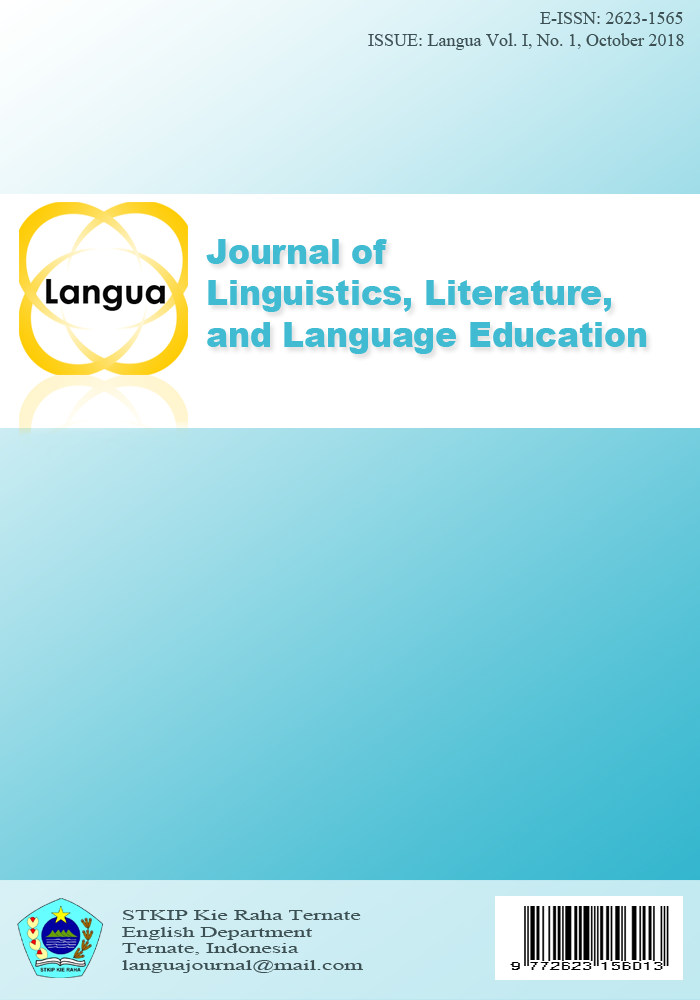The Use of Directed Reading Thinking Activity (DRTA) to Improve Students Reading Comprehension of the First Grade of Smk Pembangunan Kota Ternate
Abstract
The Purpose of this research is to know the students reading comprehension can be improve by using directed reading thinking activity (DRTA) grade x of SMK Pembangunan Kota ternate .The research of implement classroom action research in two cycles. The subject in this research is the students of grade x of SMK Pembangunan Kota ternate school year 2018-2019 with amount students 20 people. This research is using in one class, each cycle consist of four phase that is: planning, action, observation and reflecting. Based on the result of classroom action research, in Cycle I there are 4 students who have met the KKM while 16 others have not yet reached KKM is due to, pay attention to the student when the teacher’s explanation related implementation learning procedure using Directed Reading Thinking Activity (DRTA) method, activeness each student in identifying text in lucking, students activeness in making question and give the opinions in lucking. As well as the mistake that often student do incomprehension of the text as much 80%. Then in cycle II on the number of students who evaluated the overall reach KKM. This means that increasing students’ comprehension by using Directed Reading Thinking Activity (DRTA) successfully.
Downloads
References
Clarck and Ganschow (1995:72) http://selvianti29.blogspot.co.id /201 4/04/
Cline, F., Johnstone, C., & King, T. (2006) Focus Group Reaction to Three Definition of Reading (as Originally Developed in Support NARAP Goal 1). Minneapolis, M.N.: National Accessible Reading Assessment Project.
Harmer, J. (2007:99) The Practice of English Language Teaching. Malaysia: Pearson Education Limited Website citation.
Harrison, C. and Terry S. (1998). Assesing Reading 1: Theory and Practice International Perspectives on Reading Assesment. New York: Routledge.
Klingner, et, al (2007:2) http://www.wartamadrasahku.com/2017/05/definition-of-reading-comprehension.html
McKeachie, W.J. (1999). Teaching tips: Strategies, research and theory for college and university teachers. Boston: Houghton Mifflin. Weimer, M. (1996). Improving your classroom teaching. Newbury Park, CA: Sage.
Mikulecky, Beatric S. (1990:2) A Short Course In Teaching Reading Skill. New York: Addison Wesley publishing company
Neufeld. 2005. Comprehension Instruction in Content Area Classes. International Reading Association. 302–312.
Pikulski, J. J (1998,Febuary). Improving reading achievement: Major instructional considerations for the primary grades. Paper presented at the Commissioners Reading Day Statewide, Austin,TX. Cited in D.
Russell, S. (1988). http://selvianti29.blogspot.co.id/2014/04/
Stauffer, R. G. (1969). Directing reading maturity as a cognitive process. New York: Harper & Row.
Westwood.(2008) What Teachers Need To Know About Learning Difficulties. Victoria: Australian Council for Educational Research Ltd.
Authors who publish with Langua Journal of Linguistics, Literature, and Language Education agree to the following terms:
- Authors retain copyright and grant the journal right of first publication with the work simultaneously licensed under a Creative Commons Attribution License that allows others to share the work with an acknowledgement of the work's authorship and initial publication in Langua.
- Authors are able to enter into separate, additional contractual arrangements for the non-exclusive distribution of the journal's published version of the work (e.g., post it to an institutional repository or publish it in a book), with an acknowledgement of its initial publication in Langua.
- Authors are permitted and encouraged to post their work online (e.g., in institutional repositories or on their website) prior to and during the submission process, as it can lead to productive exchanges, as well as earlier and greater citation of published work.






